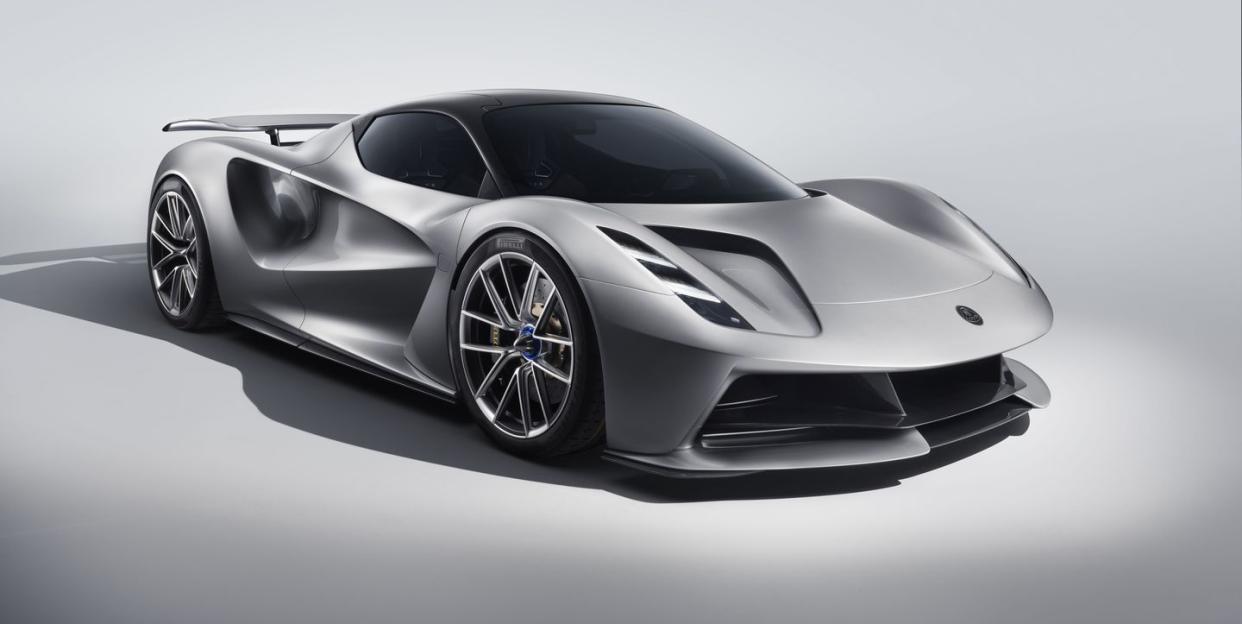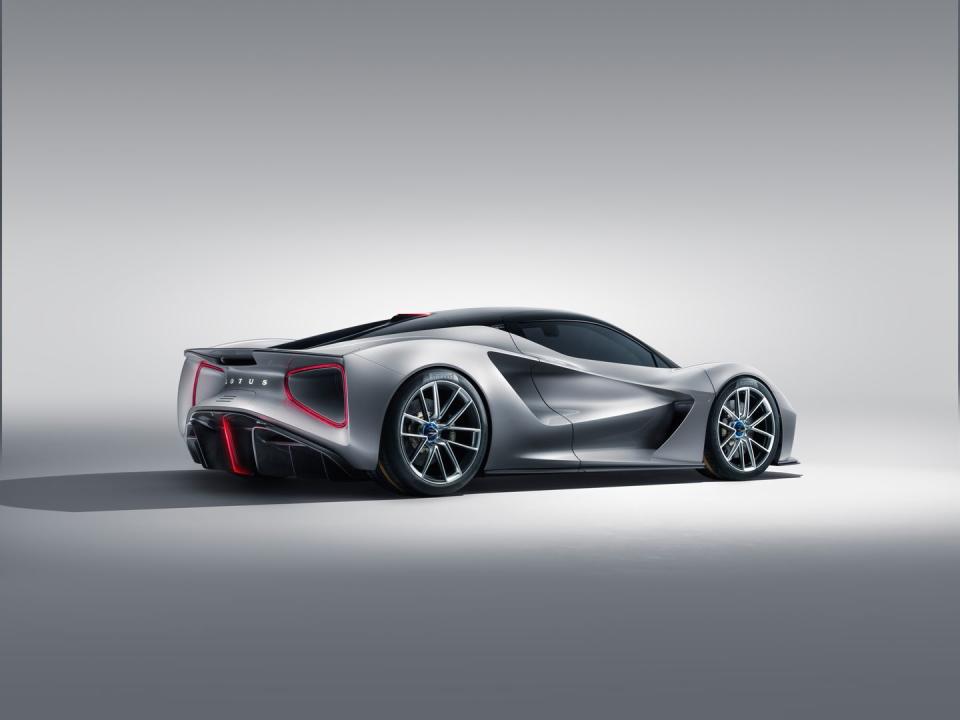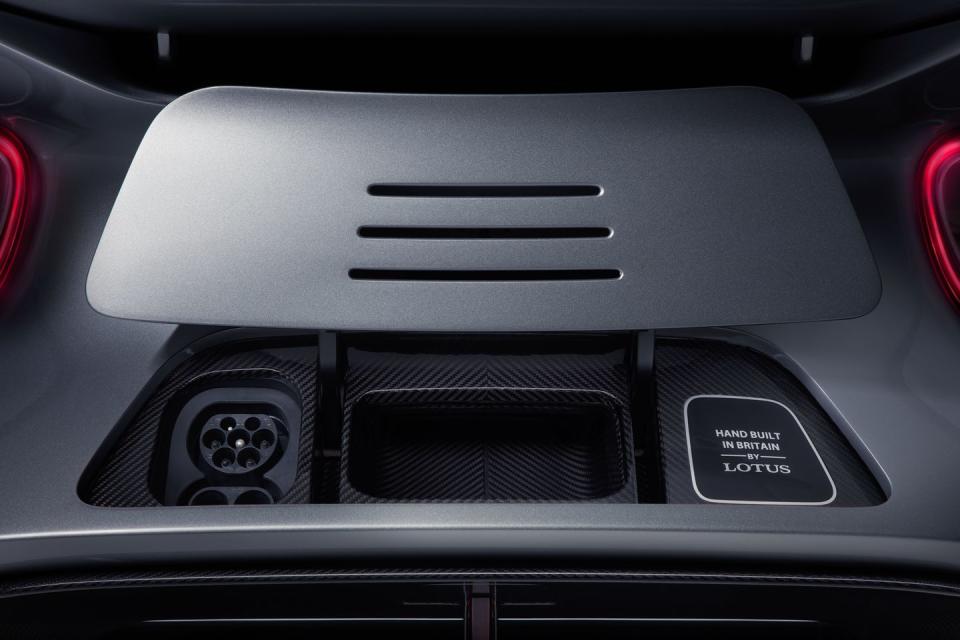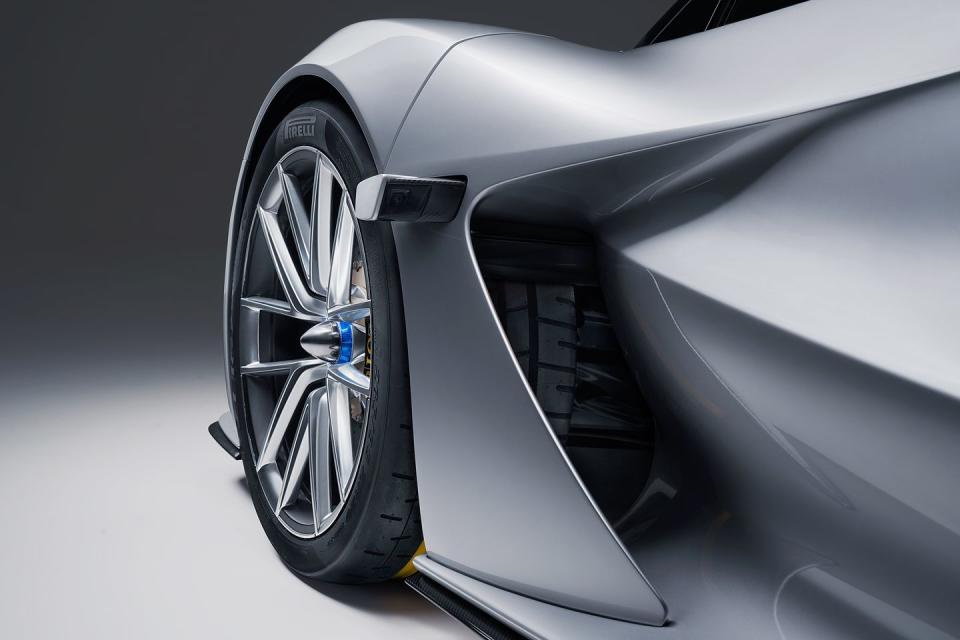Lotus Evija Aims to Be the World's Most Powerful Electric Car

Lotus wants this EV to be the world’s most powerful hypercar, targeting a 1972-hp output.
That means a sub-nine-second zero-to-186-mph time and a top speed of over 200 mph.
Lotus promises ultrafast charging that will allow an 18-minute recharge time.
Lotus is wary of corporate hubris these days, preferring to remain quiet when previously it would have shouted. Former boss Dany Bahar once introduced five sports-car concepts on the same auto-show stand, none of which made it even close to production. Lotus's resources have grown massively since the thinly applied gild of the Bahar era; Chinese automaker Geely took a majority stake in the British sports-car maker two years ago. But although the company has recruited hundreds of new engineers, and is known to be working on several new models, few details have been shared so far.
That's changing with the unveiling of the dramatic Evija. Lotus CEO Phil Popham told Car and Driver about plans for a pure electric hypercar earlier this year, and the company has dropped a teaser image and confirmed the Evija name—which we're told is meant to be pronounced E-vee-ya. The production-spec version of the car has just been unveiled at an event in London, and the car's statistics are even more radical than we were expecting them to be. Lotus says it intends the all-wheel-drive Evija to be the most powerful production road car in the world, aiming at a total output of 1972 horsepower (2000 metric horsepower) and a targeted zero-to-62-mph time of under three seconds and a top speed of more than 200 mph. No more than 130 will be built, which is a dramatic increase over the number we were told to expect at our briefing, with potential buyers able to secure a built slot with a $310,000 deposit against a full price of $2.1 million before duties and taxes.

Price and performance numbers are close to those of the Pininfarina Battista—although Lotus's claimed top speed is lower—but while the Battista uses a platform shared with the Rimac C-Two, the Evija sits on an entirely new structure, built around the first carbon-fiber tub that Lotus has used in one of its roadgoing models. Built by CPC in Modena, Italy, using a one-piece molding process, this weighs just 284 pounds. Lotus says it is targeting a total mass for the Evija of just 3700 pounds in its lightest configuration, close to three times the weight of a Sixties Elan but one that still means the Evija will be among the lightest performance EVs on the market.
Lotus developed the electric powertrain in collaboration with Williams Advanced Engineering in the U.K., a neat tie-up of two of the most famous names in Grand Prix racing. This uses a mid-mounted lithium-ion battery pack of unstated capacity that will be displayed beneath a clear cover. Drive is supplied to each wheel through a combined motor and single-speed epicyclic transmission. Each motor will make up to 493 horsepower and will also add the ability to use aggressive and almost instant torque vectoring. Total torque output across the four motors is claimed to be 1254 lb-ft.

The battery has a capacity of 70.0 kilowatt-hours but can support output of up to 2000 kW. On the intake side, the Evija will support ultrafast charging, accepting rates of up to 800 kW—which aren’t yet available through any commercial charging systems. Using an ultrafast charger producing 350 kW, the Evija's battery will reach an 80 percent charge in 12 minutes and 100 percent in 18 minutes. Lotus is claiming 250 miles of range under European WLTP testing methodology. The company also says that the system will allow battery upgrades as technology improves in future years.
The Evija has also been designed to deliver its huge performance without complaint. With four heat exchangers, the company says that the car can be driven flat out for seven minutes in its most aggressive Track mode without suffering from any battery de-rating. (That should be long enough for a serious attempt to set a "production EV" Nürburgring Nordschleife lap record.) The company also says that the Evija will have faster acceleration than internal-combustion hypercars, with under nine seconds from zero to 186 mph and the ability to go from 62 mph to 124 mph in under three seconds and from 124 mph to 186 mph in under four. For perspective, McLaren claims a 6.8-second zero-to-124-mph time for the Senna. That’s a drag race we are looking forward to conducting.
When we saw a clay model of the Evija earlier this year it was already obvious that the car has been designed for huge aerodynamic performance, with the finished car sharing the same spectacular Venturi tunnels buried through the rear haunches. The front end has some of the shovel-nose form of recent Ferraris, but closer inspection will reveal the presence of huge gaps for better airflow within the front fenders. There will also be a Formula 1–style drag-reduction system to improve performance at speed. We haven't been given any downforce numbers yet, but Lotus promises that these will be exceptional. Color us surprised if they are not. Lotus's commitment to handling fidelity is demonstrated by the continued presence of an electrohydraulic steering assistance system in place of the pure electrically assisted rack you might expect an EV to have.

The cabin is predictably tightly proportioned, but well designed and nicely finished with haptic switchgear on a central spar coming from the dashboard—the company calls it a "ski slope"—with a single digital display in front of the driver. The car will have five driving modes that can be selected by a rotary controller: Range, City, Tour, Sport, and Track. Switches to open the upward hinged doors are mounted in a roof console, a detail that Lotus design boss Russell Carr admits was inspired by the layout of the early Esprit Turbo. There aren’t conventional rearvew mirrors; instead, there's a digital system of camera pods that deploy from the sides of the doors when the car is moving.
The bad news for Silicon Valley squillionaires looking to both demonstrate their green credentials and obliterate their buddies’ conventional hypercars is that the Evija won’t be offered in the United States. But we're told that the other new Lotus models that are following rapidly behind—including a replacement for the Evora we will be seeing as soon as next year—will all be capable of crossing the Atlantic.
Few auto companies have suffered as many false dawns as Lotus, but we're starting to get excited.
You Might Also Like

